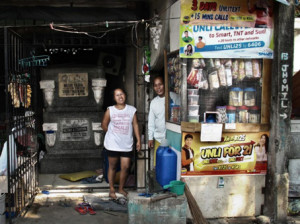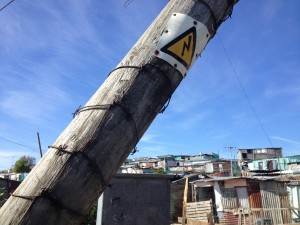Kate Holdal – Manila’s Quest To Build A Better Informal Settlement
 Nextcity.org – May, 27, 2013 – This special issue of Forefront is part of The Rockefeller Foundation’s Informal City Dialogues, a year-long collaboration with Next City and Forum for the Future taking place in six rapidly urbanizing cities around the world. The project aims to foster a conversation about creating more inclusive and resilient cities. Read weekly dispatches from our cities, watch short films and engage with others at nextcity.org/informalcity .
Nextcity.org – May, 27, 2013 – This special issue of Forefront is part of The Rockefeller Foundation’s Informal City Dialogues, a year-long collaboration with Next City and Forum for the Future taking place in six rapidly urbanizing cities around the world. The project aims to foster a conversation about creating more inclusive and resilient cities. Read weekly dispatches from our cities, watch short films and engage with others at nextcity.org/informalcity .
From the second story of his lemon-yellow home in north Manila, Alberto Legarda Evangelista, 71, surveys the leafy neighborhood he has lived in for the past decade. Below the open-air veranda where he sleeps through the humid nights, a young mother is singing a quiet lullaby to her twins. Nearby, the shouts of teenage boys playing a game of basketball float over the chuckles of their parents, who are whiling away the midday heat with playing cards and sodas.
All of this would be a postcard of suburban idyll were it not for the fact that Evangelista lives in Manila’s largest public cemetery, Cementerio del Norte, along with some 1,000 other families. Century-old tombs have been converted into stalls selling sachets of shampoo and instant noodles, flowered pathways into public washing stations, grassy knolls into doghouses. Car batteries power radios, karaoke machines and television sets; clotheslines are strung between crosses. The “home” Evangelista lives in is actually a mausoleum housing eight graves. He considers himself lucky — the breezy second story where the deceased’s family pays their annual respects doubles as his bedroom. “Look at my view,” he says, pointing his cigarette out towards the field of tombstones. He tells me this the strongest, safest home he’s ever had.
Read more: http://nextcity.org/slum-lab-manilas-quest-to-build-a-better-informal-settlement
Solenn Honorine – S. Africa Struggles To Provide Housing To Black Middle Class
voanews.com. May, 27, 2013. South Africa’s black middle class is growing by leaps and bounds – with a new survey showing it now outspends the white middle class. This is having a profound impact on the historical black township of Soweto where prices of land and houses have soared in recent years due to growing demand for better housing.
Protea Glen, an extension of Soweto, is designed to accommodate the needs of the black middle class. It has all the same features as the housing of choice of most well-off South-Africans: you need a special permission to enter the premises; it is guarded 24/7 by a private security company; it is surrounded by a tall electric fence; and its common areas boast neat lawns.
Read more: http://www.voanews.com/south-africa-struggles-to-provide-housing
Global Monitoring Report 2013 : Rural-Urban Dynamics And The Millennium Development Goals
openknowledge.worldbank.org
World Bank; International Monetary Fund. 2013. Global Monitoring Report 2013 : Rural-Urban Dynamics and the Millennium Development Goals.
© Washington, DC: World Bank. https://openknowledge.worldbank.org/handle/10986/13330 License: CC BY 3.0 Unported.
The Global Monitoring Report 2013: Rural-Urban Dynamics and the Millennium Development Goals examines rural-urban disparities in the achievement of the Millennium Development Goals (MDGs) and how urbanization, if managed well, can contribute to the attainment of these goals. The report provides information about the differences in progress toward the MDGs across geographical areas and recognizes that urban populations are better off than their rural brethren. However, unfettered urbanization can cause migrants and the urban poor to end up in slums where attainment of the MDGs lags. GMR 2013 calls for an integrated strategy to better manage the planning-connecting-financing formula of urbanization. Notwithstanding the importance of urbanization in poverty reduction and MDG attainment, rural areas remain a huge challenge—one that underscores the importance of policies that can improve rural livelihoods. The rural-urban spectrum ranges from small towns to large cities. The general experience is that poverty is lowest in the largest cities and considerably higher in smaller towns. The MDGs reflect the basic needs of all citizens, and governments should aim to meet them fully in both urban and rural areas. However, resources are scarce, so priorities must be set and trade-offs made. The report argues that the sequencing of actions be tailored to local conditions when it comes to the degree of urbanization and rural-urban differences in MDG outcomes. The world has met four global MDG targets. New estimates confirm the 2012 reports that MDG 1.a—reducing the $1.25-a-day poverty rate (2005 purchasing power parity)—was reached in 2010, falling below half of its 1990 value. The world also met part of MDG 7.c—to halve the proportion of people without safe access to drinking water—in 2010. MDG 7.d—to improve significantly the lives of at least 100 million slum dwellers by 2020—was also achieved. Finally, the first part of MDG 3.a—to eliminate gender disparity in primary education— was accomplished in 2010. Global progress on the full MDG 3.a (to eliminate gender disparity in primary and secondary education) is close to being on track. Global Monitoring Report 2013 was prepared jointly by the World Bank and the International Monetary Fund, with consultations and collaborations with regional development banks and other multilateral partners.
Read more: https://openknowledge.worldbank.org/handle/10986/13330
Danijel Majic – Die Slums in der Mitte Europas
Frankfurter Rundschau. Der Dokumentarfilm „Slumdogs“ ist ein Versuch, Roma ihr eigenes Bild von sich und ihrer Situation zeichnen zu lassen. Lidija Mirkovic erhebt damit den Anspruch, neue Bilder gegen alte Klischees zu setzen.
Wie oft sie die Aufnahmen auf ihrem Laptop schon betrachtet hat, kann Lidija Mirkovic gar nicht genau sagen. Zumindest so oft, dass sie sie schon fast auswendig kennt. Gesichter, die in die Kamera sprechen, Straßengeräusche aus den Belgrader Vorstädten. Menschen die in Bretterverschlägen sitzen, Müllhalden durchwühlen. Szenen eines Flohmarkts im Morgengrauen, irgendwo in der serbischen Provinz. Eine ganze Barackensiedlung im Schatten einer Autobahnbrücke. Auf Mirkovics Computer lagert eine riesige Materialsammlung, die sich schon bald zu einem Dokumentarfilm verdichten soll. „Slumdogs“ wird er heißen und Geschichten aus der Mitte Europas erzählen.
Weiter lesen: http://www.fr-online.de/roma-die-slums-in-der-mitte-europas
Andre Vltchek – The Toughest Slums On Earth
dissidentvoice.org – NAIROBI — They tell you ‘peace’, but you know you are living in a warzone. You know it from the start; you’ve sensed it ever since you were a very little boy or a girl. You wake up every morning, not certain whether you will witness another dusk, whether you will experience another sunrise.
A bullet can hit you at any moment while you are walking down the road. If you are a woman, you can be ambushed and dragged into a dark back alley or filthy shack along the way, then raped.
The police are very hard to find, and are hopelessly corrupt. You prefer not to seek their ‘assistance’. You are really on your own: you own no gun, you don’t belong to a gang, and you are extremely poor.
You are exposed.
Around where you live, there are bullets flying and fires burning. Once in a while a gasoline truck explodes, or an entire gangway of some miserable hovels bursts into flames. Loud salvos of sub-machine guns often penetrate the night.
Read more: http://dissidentvoice.org/the-toughest-slums-on-earth/
Amnesty International Slams Slum Evictions
dw.de – May, 23, 2013 – Tens of thousands of people worldwide were pushed out of slum dwellings last year to make way for shopping malls and office blocks, according to Amnesty International. Nigeria witnessed especially brutal clearances.
The bulldozers came to the settlement just before midday, when most people were busy at work. Resident Jim Tom George was there to see over 20,000 people forcibly evicted from their homes in Port Harcourt, Nigeria.
“They blocked the entry points to our settlement and just started to demolish everything,” he says of the day in June 2012. “They didn’t tell us. We had no idea that the government would arrive on this day and destroy the place where we all live.”
Read more: http://www.dw.de/amnesty-international-slams-slum-evictions



